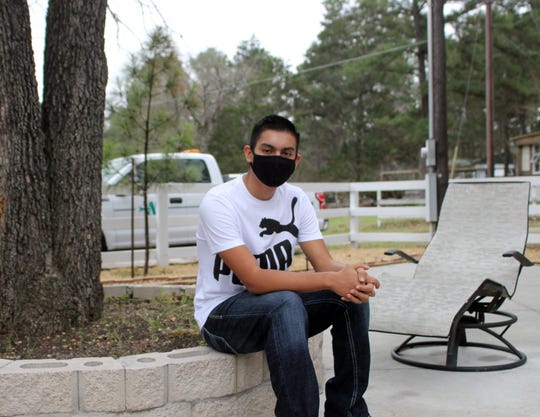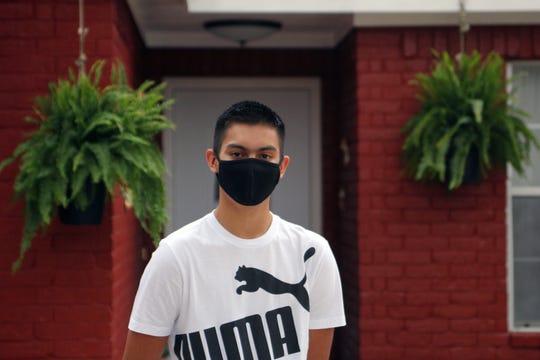Pandemic reduces number of high school students taking dual enrollment courses
Like many students taking college courses during the coronavirus pandemic, Alexis Lopez struggled with a poor Wi-Fi connection and professors who didn’t offer much support.
“They couldn’t really help us. They didn’t really know what to do for us,” said Lopez, who remembers becoming so frustrated in front of her computer that she burst out crying. “We had to do everything by ourselves.”
Unlike most college-goers, however, Lopez, who lives in Bastrop, Texas, is still a senior in high school. And the problems forced her to withdraw from two of these classes, saddling her with two unwanted W’s on her transcript.
“I’ve never had to withdraw from a course until the pandemic hit,” she said. “That’s what I didn’t want.”
At 18, Lopez is among what varying estimates say is 10% to 34% of high school students who take college-level courses that give them a head start on credits, save time and money, and prepare them for the demands of higher education.
But the number of students enrolling in and passing these classes has started slipping – dramatically, in some places – suggesting a potential decline ahead in the number of high school students who end up going to college. For those who do go, it means earning a degree could take longer and cost more.
“It definitely throws them off track,” said Samuel West, District P-16 director at Houston Community College.
Bryan Gonzalez-Alcantar, a junior at Colorado River Collegiate Academy in Bastrop, Texas, put off taking his dual enrollment college courses until this summer because of the pandemic. “It does slow me down a little,” he said. (Photo: Jackie Mader/The Hechinger Report)
The increasingly popular practice of taking college courses while in high school – an umbrella that includes dual credit, concurrent enrollment and early college programs – is often a free or low-cost way of accruing college credits, sometimes shaving two years off the time it takes to get an undergraduate degree.
Dual enrollment also increases the likelihood that students will go to college, research suggests. A Colorado study found that those who took dual and concurrent enrollment courses were 23% more likely to enroll in college than their classmates who didn’t. They also do better once they get there: Students who took dual credit before going to four public universities in Texas were more likely than their peers to earn bachelor’s degrees within six years, another study found.
Participating in dual enrollment “helps students move their gaze from a few feet in front of them to a point further on out on the horizon and start on that road,” said Amy Williams, executive director of the National Alliance of Concurrent Enrollment Partnerships.
COVID and schools: Kids going back to school in a pandemic are met with another trauma: Active shooter drills
As the U.S. enters the second year of an economic downturn caused by COVID-19, dual enrollment offers a way for students to earn degrees and certificates they need to boost job prospects while saving money. Three in 10 students in early college have already earned an associate degree or other postsecondary credential when they finish high school, Jobs for the Future reports.
“When times are tough, students get very considerate about what are the education pathways that are going to result in them being able to get themselves a good-paying job as quickly as possible,” said Alex Perry, coordinator of the College in High School Alliance.
But while dual credit, concurrent enrollment and early college courses could help young people overcome financial and educational obstacles linked to the public health crisis, the infrastructure that makes them possible has been facing its own challenges during a year of shuttered campuses and surging infections.
As colleges reconvened for their first full semester during the pandemic in the fall, undergraduate enrollment among students under 18 – a proxy for college in high school – was essentially flat after a big increase the year before. By the spring, enrollment for that age group had declined by nearly 3%.
“Generally, if fewer students are taking dual enrollment that’s likely to be a net negative for college access and enrollment after a student graduates high school.”
“Generally, if fewer students are taking dual enrollment, that’s likely to be a net negative for college access and enrollment after a student graduates high school,” Perry said.
The trend hit unevenly across the country, with some colleges seeing increases while others suffered double-digit nosedives. In Idaho, for example, the number of students taking dual enrollment courses through Boise State University plummeted by 37% in the fall. Idaho State University and the University of Idaho also reported significant drops.
During a chaotic and uncertain academic year, some courses also “just weren’t offered because we couldn’t guarantee that [students] were going to be in school,” said Mercedes Pour, director of college access for the Maine Community College System.
Even when dual enrollment programs were available, high schoolers grappling with remote learning sometimes didn’t do as well as they wanted to, administrators said.
The Highland campus of Austin Community College in Texas. Success rates dropped during the fall in dual enrollment courses offered by the college when students withdrew more often than usual. (Photo: Jackie Mader/The Hechinger Report)
Success rates dropped during the fall in courses offered by Austin Community College in Texas when students withdrew more often than usual. Part of the problem is that high school students haven’t had as much time to study after taking jobs during the recession, said Mison Zuñiga, ACC’s interim associate vice president of college and high school relations.
“We just are seeing things that we’ve not seen in a long time for high school students, that are just a part of what this pandemic has definitely brought to surface,” Zuñiga said.
Other high school students taking college coursework had a hard time shifting to remote learning. Still others were dissuaded from taking additional credits because of the potential effect on their academic records of a bad grade or withdrawal.
Bryan Gonzalez-Alcantar, a junior who, like Lopez, goes to Colorado River Collegiate Academy in Bastrop, Texas, wanted to take advanced summer courses last year until his counselor recommended against it, worried that extra classes not required for his degree could affect his grade point average.
“It does slow me down a little, since now I have to take them this summer instead of last summer,” Gonzalez-Alcantar said.
Bryan Gonzalez-Alcantar, a junior at Colorado River Collegiate Academy in Bastrop, Texas, put off taking his dual enrollment college courses until this summer because of the pandemic. “It does slow me down a little,” he said. (Photo: Jackie Mader/The Hechinger Report)
The fallout from poor performance can be serious. Dual enrollment students are creating a college GPA, and if they fail a class, they could incur debt retaking it after high school, find themselves ineligible for financial aid because of rules about maintaining satisfactory academic progress or lose their competitive edge for admission and scholarships that comes with successful college course completion in high school.
“That academic record follows them for the rest of their lives,” said West of Houston Community College.
‘Expectations are no different’: Students are struggling to read behind masks and screens during COVID-19
Success rates at HCC dipped from 89% in 2019 to 85% last fall for regular dual credit students and from 80% to 74% for those in early college high school programs, according to the college’s data. Male students of color struggled the most with classes, West said, as did students whose courses shifted to a format that could be completed at any time, instead of being offered on a specific schedule.
Black and Latino students already participate in dual enrollment at lower rates than their white counterparts. Some students can’t afford tuition, fees or transportation costs where they’re required, or they go to high schools that provide them with comparatively poor preparation, according to the Community College Research Center at Teachers College, Columbia University. (The Hechinger Report, which produced this story, is an independent unit of Teachers College.)
Amid COVID-19, Black Americans and Latinos have also faced disproportionately higher rates of economic hardship, hospitalization and death from the virus. Meanwhile, students of all backgrounds have suffered mental health challenges including depression and anxiety, the mental health awareness nonprofit Active Minds found in a survey.
“This is a time where I’m not sure people should be taking on a little bit more, and that’s what dual enrollment is.”
“This is a time where I’m not sure people should be taking on a little bit more, and that’s what dual enrollment is. You know, it’s a little bit more on top of your secondary curriculum,” said Pour of the Maine Community College System.
Near the beginning of the pandemic, Lopez cared for her grandfather after he got sick and then broke his hip in a fall, washing him and changing his diapers while trying to manage schoolwork.
When she was at home and had access to a vehicle over the last year, she often would drive to a library or parking lot, then lock herself inside her car for reliable Wi-Fi. People weren’t wearing masks inside buildings, she said, and she preferred to study alone.
“I just wanted my year to be better,” she said. “I just wanted to go to school.”
This story was produced by The Hechinger Report, a nonprofit, independent news organization focused on inequality and innovation in education. Sign up for our higher education newsletter.
Source: Read Full Article




